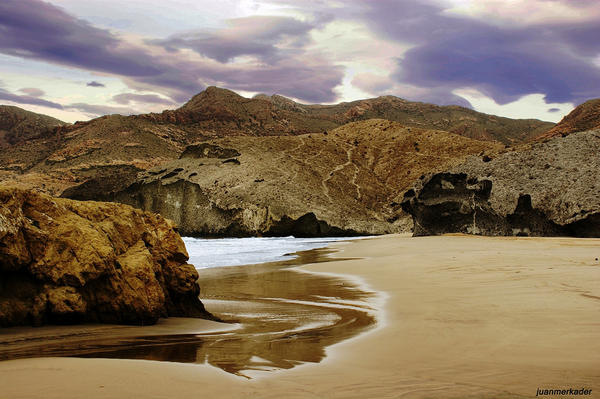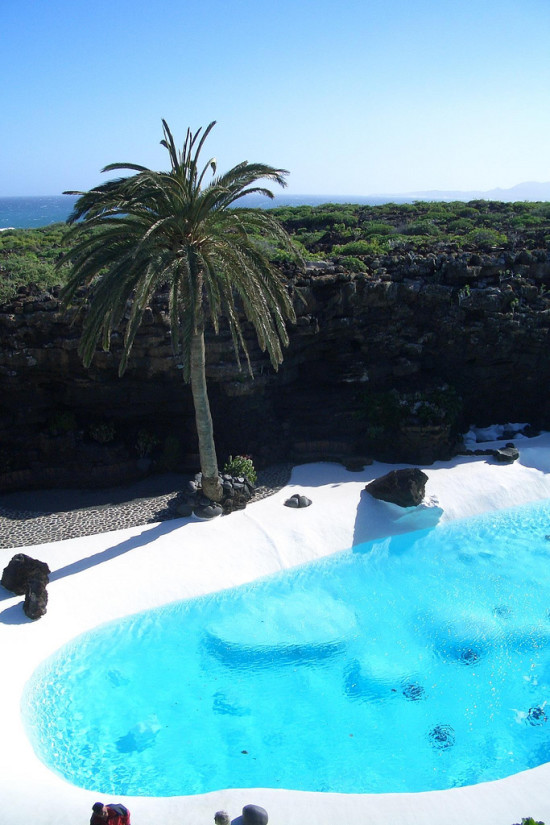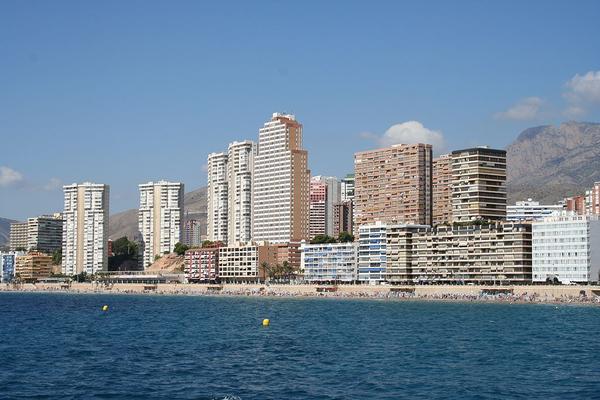The coastline of Spain attracts travelers with its spectacular beaches. Spain’s sands are often bustling with tourists whose umbrellas and coolers clutter the landscape. Far from the fiesta atmosphere these beaches provide, Spain’s more undeveloped stretches of coastline harbor a string of magnificent, unspoiled beaches. Tucked along the cliff-filled coast of southern Spain’s Cabo de Gata-Nijar Natural Park is Mónsul Beach.

- Mónsul Beachjuanmerkader / Beach Photos / CC BY-NC-ND
As luck would have it, the rain in Spain rarely falls on this remote terrain, making it even more attractive to adventurous beachgoers. Its shallow, coral-filled waters provide for five-star snorkeling and casual swimming. The destination is a five-hour drive from the Madrid-Barajas Airport and sprawling cosmopolitan attractions. A number of accommodations around the airport are available at http://www.venere.com/madrid/
As you approach Mónsul, you are greeted with an ever-evolving landscape of huge sand dunes. Beyond them lies an expanse of white sand flanked with what appear to be gigantic stone sculptures. You may become disoriented from the lunar landscape, but you’ll find you’re not on the moon — you’re on Mónsul.
Volcanic Vistas
The prominent rock formations dominating the scenery at Mónsul Beach are described by visitors as resembling giant walruses, mammoth mushrooms and huge snails. The formations have a distinctive smooth texture reminiscent of the famous building façades of Spain’s most famous architect, Antoní Gaudi. Slabs of rock jut out from the smoother rock in a pallete of surprising hues. Combined with the backdrop of undulating cliffs,Mónsul appears as a surrealist painting with vibrant shocks of color.
The rocks and cliffs of the beach are so varied in appearance because they are all remnants of separate volcanic eruptions. The sands are deep brown and black, the remnants of ancient lava flows. Between the cliffs and the ocean, the beach is strewn with hefty boulders piled up as if thrown by giants. There is a moonlike vibe to the coastline that allows the imagination to soar. Colors of rust, orange, mustard, white, purple and even emerald green are evident in the natural geological museum that is Mónsul.
A Claim to Fame
Surrounding Mónsul is an expansive vista of prickly pear cactuses, dwarf palm trees and agave plants. The scene is reminiscent of Mexico and Texas — probably the reason why the coast near Mónsul and the adjacent countryside is a popular location to film movies, television series, music videos and advertisements.
This strange Spanish beach is also home to thousands of pigeons, and not just any pigeons: famous pigeons. A persistent urban legend holds that the pigeons inhabiting Mónsul Beach today are the descendants of those used by Steven Spielberg during the filming of “Indiana Jones and the Last Crusade.”
Near the end of that movie, Indiana Jones (Harrison Ford) and his father, played by Sean Connery, are attacked from a plane that swoops down over the beach. In the scene, Connery used his umbrella to scare a flock of seagulls that then engulfed the plane as it crashed into one of the beach’s cliffs. Spielberg used pigeons instead of seagulls to shoot the scene.
When you’re at Mónsul, not only are you in the company of winged cinema stars, but you are also treading on the same sand once touched by the feet of two legendary Hollywood actors.
Perfect for Pirates
The clear water and curious rocks of Mónsul beach are a short drive from several antiquated fortresses and watchtowers, some over 1,000 years old. Most of them were built to fend off pirates and other invaders. There are tales of pirates landing at Mónsul and having hedonistic fiestas amid its secluded sands. Today, pirates are few and far between. The beach is a haven for families and young children awed by the pirate mystique.
A Healthy Dose of History
The nearest city to Mónsul beach is Almeria, an ancient harbor of great strategic value to Caliphate of Cordoba. Almeria was the setting for many religious sieges during the Crusades and for a series of violent earthquakes in the 16th century. Packed with medieval fortresses, lookout towers and underground passages, the vibrancy of Almeria’s human history is a compelling complement to the geological history at Mónsul Beach.
About the Author: Louise Vinciguerra is a fantastic joke teller, has a million and one hobbies, and enjoys matching her fonts with her moods. This Brooklyn native dirties her hands in content on weekdays and as a devout nature lover, dirties them in soil on the weekends. When she’s not on Facebook, WordPress or Twitter, she’s traveling in search of fun food, dabbling in urban farming or planning nature trips from her resident city of Rome. When she’s not doing any of the above, she sleeps.


